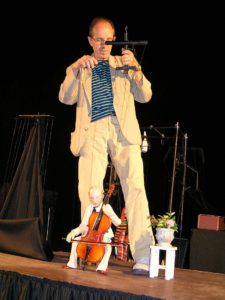Language and the brain – Exploring fast-tracks for learning new languages
Although progress has been made in the area of language acquisition research, contributing with new insights, many teaching methods are still based on outdated assumptions. This is why the Center for Middle Eastern Studies wants to adapt their language courses to better meet students’ needs.
Rafah Barhoum and Helen Avery’s research investigates how students perceive new approaches within language teaching. The background to the project is that students enrolled in the MA program in Middle Eastern Studies had to learn Arabic quickly, to be able to do field work and operate within Arabic speaking contexts. But beyond exploring new ways for students to pick up Arabic at a fast pace, Barhoum and Avery believe that their findings will benefit much wider societal challenges.
Way back in the 1970s and 80s, there was some debate about the general principles governing language learning and how language related to the human brain. Different hypotheses were set forward, which were often deliberately schematic. They were presented as mutually exclusive, and some experiments were set up to prove or disprove these ideas. So, for instance, theorists would ask if learning languages was innate and universal, or specific to a culture, or dependent on exposure. Current research on language is of course much more varied and less schematic, but what we seldom realise is the extent to which language teaching approaches continue to be based on quite simplistic models and metaphors. So whereas there used to be a debate on what should work in language teaching, and why, today much of the underlying assumptions are just taken for granted.
An example is the persistence of the behaviourist ’Black box’ metaphor – that is, not considering learners as active or conscious – which reduces learning to sets of automated responses. In teaching practice, this might translate to using drills, working with small decontextualised segments of language that can be repeated until they are automated – a bit like learning scales when practicing an instrument. The downside is of course separating language use from meaning and meaningfulness for the student, but also the construction of quite artificial segments to be memorised, outside any social context.
At the opposite end of the spectrum, we have the metaphor of the ’Puppeteer’, that is, the idea that language production and comprehension involves deliberate decisions by our conscious self. In fact, it is doubtful that using the very limited resource of conscious attention to understand, memorise and reproduce elements of language is rational. Conscious attention can be used to monitor and correct language production, but overemphasising correction easily becomes inhibitive. Another problem is that seeing language ability as a cohesive ’mental’ faculty tends to obscure how language depends on a very wide range of motor skills, perception and attention, spatial representation, sense of rhythm, etc.
Despite the differences between such metaphors, however, the assumption is that students will be able to use their knowledge of textbook representations of the language as stepping stones to later move out into an actual communicative situation. For Arabic, the problems with this assumption become very clear. There is a great difference between textbook descriptions of standard Arabic and the language as it is used. The large number of varieties of Arabic means that understanding geographical and social context of use becomes especially important. Additionally, the major differences between spoken and written forms oblige us to understand the relationships between various verbal skills. Another crucial point is that for learners who are familiar with Latin systems of writing, reading and writing in the opposite direction becomes a challenge, and then it will take time before the student can gain speed and ease. So, the role of motor skills and eye movements becomes obvious in this case, and we really have to think about how these interrelate to the way we understand language learning.

The Puppeteer: Consciously controlling every movement
At the Centre for Middle Eastern Studies, Arabic is an elective offered to our Masters students. These students are busy with their other coursework, and have little time to focus on studying Arabic. At the same time, they have high expectations, since they want to actually use the language for research and work after some months, and quite often in rather complex contexts in the field. To do so, they would have to progress much faster than in conventional courses. So, these are quite extreme conditions compared to other academic learning contexts, but at the same time this is what makes findings from this learning situation relevant to wider societal challenges.
The teaching approach currently used at the CMES builds on authentic materials. Other elements include involving culture, providing opportunities for lived experiences outside the classroom, engaging various senses through food and music, as well as building on the students’ own motivation and their personal projects for using the language. These diverse elements in the teaching design are founded in much of what we know today about perception, learning and language production, but the question is of course how ideas about what ‘should work’ actually translate into practice.
This research project looks at how students perceive the approach, since our students are adult learners who bring with them their own learning approaches and routines that they have acquired through earlier studies, and which they use to interpret the new context.
Findings from our research have relevance for teaching Arabic, of course, but there is generally a need to reconsider how we approach language teaching. For instance, massive forced migration is creating the need for strong approaches to teaching and learning languages at a much quicker pace than we have seen so far. It is just not acceptable to count the first generation of displaced and refugees as ‘lost’ due to insufficient linguistic proficiency, so this really means quickly learning how to learn more effectively. Methods can be used for newly arrived migrants to learn Swedish.
Text: Helen Avery
Facts
-
Three questions to Helen Avery
-
What makes the methods used at CMES unique?
The approach we use builds associations between ‘verbal’ skills and quite different functions. Using authentic materials allows students to recognise the language in forms they will actually meet, and also relates the language that is practiced to much more concrete contexts. This is in fact associating what we would normally call ‘language’ learning to the numerous mechanisms we have to recognise situations more generally, relate to each context and act appropriately. Our automatisms based on proficiency in other languages usually create some initial difficulties approaching a new language because perception is filtered. This is also why working with music is often a powerful method, both because we can switch to other filters and because we latch onto rhythm as a support for movement and memory.
Why do you think the CMES method is more efficient than using the black box or puppeteer approach?
A shared problem with approaches to teaching based on the Black box and Puppeteer metaphors is that they conceptualise language as something abstract and disembodied. Also, that they tend to dissociate language learning from what matters to students as specific individuals, and from what makes each language unique.
Which methods/ways will you apply in your research project to find out?
The project involves questionnaires with open-ended questions to the students, to learn more about how they perceive the approach.







